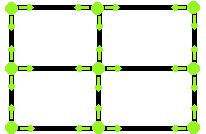Positions on Screen are an important knowlage when using this whole UI-Frame feature. Warcraft 3 was at the beginning a 4:3 only Game. Hence their own UI-FrameWork has a coordinate system that makes sense for the 4:3 part.
The Position goes from 0.0/0.0 at the Bottomleft (Minimap) to the Topright with 0.8/0.6 (Upkeep Level). The used Resolution does not matter, this values do not change. This Values are also used for Size of Frames. Pixel based size/Coords are only doable with some conversion math.
Coords are for the 4:3 Screen
|0.0/0.6 0.8/0.6|
| |
| 0.4/0.3 |
| |
|0.0/0.0 0.8/0.0|
>
One can imagine Frames as rectangles when one sets size and position. When only one FramePoint is placed the choosen FramePoint has a strong impact on the result. It limites the directions the Frame expands.
When using a point containing:

Custom created Frames from the Frame group can not leave the 4:3 part of the screen. If a part of them leave it, they become malformed. A TEXT-Frame might cut off some chars. A BACKDROP becomes smaller and with that also Buttons and many others etc.
SimpleFrames are free from that limitation.
One can free Frames from that 4:3 limitation by creating them for a different Parent then GAME_UI, in Reforged such a Parent could be ("ConsoleUIBackdrop",0). Through that don't comes with a price. Using ("ConsoleUIBackdrop",0) as parent pushes them to a lower Layer, below SimpleFrames. One also could use BlzGetFrameByName("Leaderboard", 0) or BlzGetFrameByName("Multiboard", 0). This are above SimpleFrames but one has to create them first with the none Frame api. Your custom Frames can also be a child's child of that other Parents, the 4:3 Limitation is still gone.
When one creates frames in fdf one can also set the position of frames. Here one has 2 to 3 options based on the current Frame:
This is an example fdf-Frame without UseActiveContext. It is not used because the frame shall attach itself to ("ConsoleUI", 0) even when created with a CreateContext that is not 0.
That Frame of type BACKDROP with Name "Test" displays when created a Paladin-Icon at Top Left of the screen (The fdf containing that would have to be loaded over a toc first).
Frame "BACKDROP" "Test" {
Width 0.1,
Height 0.1,
SetPoint TOPLEFT, "ConsoleUI", TOPLEFT, 0, 0,
BackdropBackground "ReplaceableTextures\CommandButtons\BTNHeroPaladin",
}